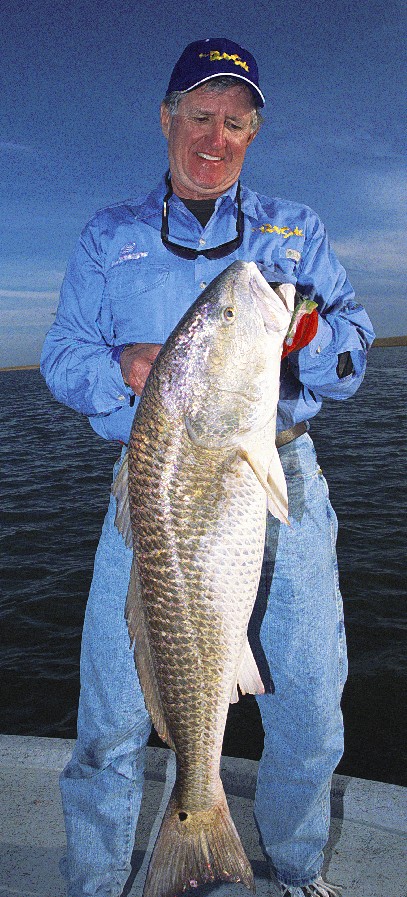Monsters of the marsh
Boisterous bull redfish attract anglers from all over the world to the Mississippi Delta

There are a few places in the world that rank as “must-go angler destinations.”
Bonefishermen haven’t lived until they have fly-fished for the silver torpedoes in the shallow waters of Christmas Island in the South Pacific.
Stream anglers consider a trip to the South Island of New Zealand nothing short of a holy pilgrimage.
Snook enthusiasts know the waters of Costa Rica hold their best shot at a world record, regardless of line class.
But if redfish are your passion, few will argue the coastal waters of Louisiana are as close as you will get to an angler’s paradise.
“I have fished all over the world,” said Wal-Mart FLW Redfish Series competitor Ray Van Horn. “And I have got to tell you that Louisiana is one of those must-go places.”
Van Horn and his tour partner, C.A. Richardson, both hail from the West Coast of Florida, the location of several tournaments on the FLW Redfish Series.
“Louisiana has always been a heartbreaker for us,” Richardson said. “I think every time we have fished there, we have finished second. We are always close, but not close enough.”
Van Horn said the biggest adjustment he had to make in fishing “The Pelican State” is keeping an open mind.
“In Florida, we are always working the shoreline,” he said. “But in Louisiana you have so many different types of water. The possibilities are endless.”
When asked why he thought Louisiana had the best red drum fishery in the Gulf of Mexico, Van Horn’s answer was simple – the Mississippi River.
The famed “Big River” drains 28 states and three Canadian provinces, bringing rich nutrients to the shallow waters south of New Orleans. The marshes, bays and canals provide endless nursery areas for the young of the species as well as a variety of forage fish.
“There is so much habitat,” Van Horn said. “The fish are big and plentiful. It’s like the Jurassic Park of fishing.”
A surprisingly long-lived species, red drum can live to be 40 years old. Spawning season runs August through October, and within a year, a hatchling will reach an average length of 14 inches. By the second year, a Louisiana red will measure 18 to 24 inches and weigh 3 to 6 pounds. By year three, these drum will be 28 inches and weigh 9 pounds. But after that, most of the fish move to deep water and join the big schools of spawning bull reds.
Even though the bulk of the school will move offshore, many big fish remain close to land, where they are targeted by anglers with light tackle.
“The first time I fished up there, I was working the bank when I heard an explosion in the water behind me,” Van Horn said. “When I turned around, I saw a red that must have weighed 35 pounds working a school of shad.”
Big bull reds are why anglers come from across the United States and throughout the world to fish the Mississippi Delta. Tie into one of these tackle-busters on light line, and you are in for a Louisiana sleigh ride.
 Five of the 11 standing International Game Fish Association saltwater flyrod records were set in Louisiana, including a 41-pound, 10-ounce monster that was caught on a 20-pound-test tippet in January 2004.
Five of the 11 standing International Game Fish Association saltwater flyrod records were set in Louisiana, including a 41-pound, 10-ounce monster that was caught on a 20-pound-test tippet in January 2004.
“Whenever I go up there to fish, I have to go up in pound test,” Van Horn said. “You can get away with 10-pound test in Florida, but up there, I won’t use anything less than 20-pound test. You can’t control a fish like that with anything less.”
Louisiana’s fishing regulations, liberal for the Gulf of Mexico, are also a big attraction. Prior to 1977, the recreational fishery was unregulated. But by the late ’80s, the hunger for “blackened redfish” forced fishery managers to impose a slot limit of 16 to 27 inches and a five-fish bag limit.
While Gulf reds don’t generally get as big as their Atlantic counterparts – the IGFA all-tackle record of 94 pounds, 2 ounces was set in North Carolina – Louisiana gets its share of big fish.
“It is not uncommon to catch 40-pound fish,” said Darren Angelo, an FLW Redfish Series pro from New Orleans. “October through March is definitely the time to go after big fish. They like colder water.”
Angelo uses artificial lures tied to 30-pound-test line when targeting big breeders.
“You can catch these big fish on the flats early in the morning and late in the afternoon when the water cools down,” he said. “You will find them cruising the channels at times as well.”
Angelo, who also owns the Marshland Hunting & Fishing Lodge in Port Sulpher, said anglers looking for quantity should fish any of Louisiana’s rivers.
“Those fish tend to be smaller by a pound or two,” he said. “I think that is from constantly swimming against the current. They burn up a lot of calories.”
Van Horn, who has fished for redfish in both the Atlantic Ocean and the Gulf of Mexico, thinks Louisiana reds are easier to catch than their Florida counterparts.
“I won’t say they are stupid,” Van Horn said, “but they don’t get hit as hard. In Florida, the fish have so much pressure that they can be very wary. They have seen just about everything, and as a result, it can be really hard to get them to bite.”
So, in short, the Mississippi Delta is loaded with giant bull reds that are less pressured and more than willing to bite. That definitely puts it on the list of “must-go” angler destinations.